2016 NISSAN MURANO HYBRID maintenance
[x] Cancel search: maintenancePage 417 of 443
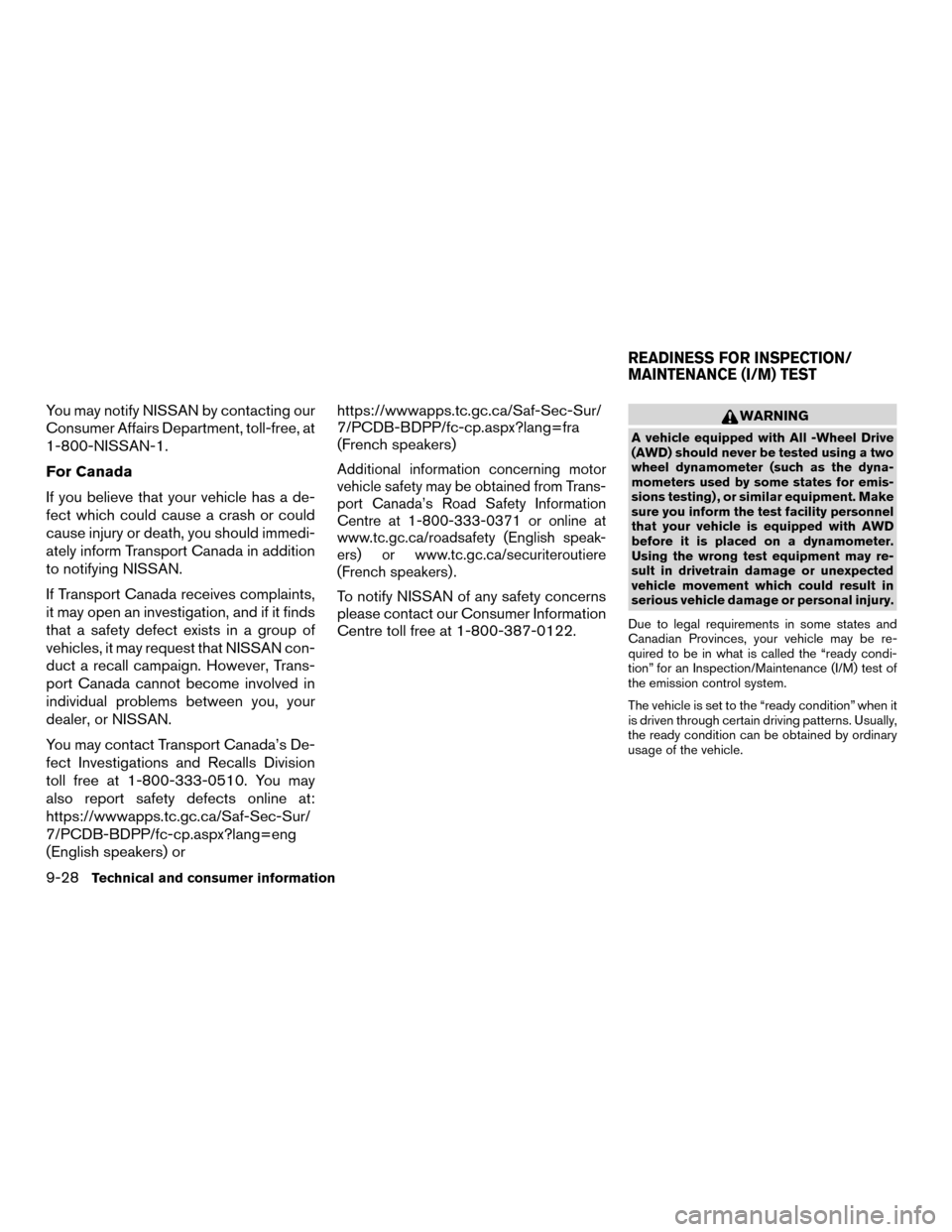
You may notify NISSAN by contacting our
Consumer Affairs Department, toll-free, at
1-800-NISSAN-1.
For Canada
If you believe that your vehicle has a de-
fect which could cause a crash or could
cause injury or death, you should immedi-
ately inform Transport Canada in addition
to notifying NISSAN.
If Transport Canada receives complaints,
it may open an investigation, and if it finds
that a safety defect exists in a group of
vehicles, it may request that NISSAN con-
duct a recall campaign. However, Trans-
port Canada cannot become involved in
individual problems between you, your
dealer, or NISSAN.
You may contact Transport Canada’s De-
fect Investigations and Recalls Division
toll free at 1-800-333-0510. You may
also report safety defects online at:
https://wwwapps.tc.gc.ca/Saf-Sec-Sur/
7/PCDB-BDPP/fc-cp.aspx?lang=eng
(English speakers) orhttps://wwwapps.tc.gc.ca/Saf-Sec-Sur/
7/PCDB-BDPP/fc-cp.aspx?lang=fra
(French speakers)
Additional information concerning motor
vehicle safety may be obtained from Trans-
port Canada’s Road Safety Information
Centre at 1-800-333-0371 or online at
www.tc.gc.ca/roadsafety (English speak-
ers) or www.tc.gc.ca/securiteroutiere
(French speakers) .
To notify NISSAN of any safety concerns
please contact our Consumer Information
Centre toll free at 1-800-387-0122.
WARNING
A vehicle equipped with All -Wheel Drive
(AWD) should never be tested using a two
wheel dynamometer (such as the dyna-
mometers used by some states for emis-
sions testing) , or similar equipment. Make
sure you inform the test facility personnel
that your vehicle is equipped with AWD
before it is placed on a dynamometer.
Using the wrong test equipment may re-
sult in drivetrain damage or unexpected
vehicle movement which could result in
serious vehicle damage or personal injury.
Due to legal requirements in some states and
Canadian Provinces, your vehicle may be re-
quired to be in what is called the “ready condi-
tion” for an Inspection/Maintenance (I/M) test of
the emission control system.
The vehicle is set to the “ready condition” when it
is driven through certain driving patterns. Usually,
the ready condition can be obtained by ordinary
usage of the vehicle.
READINESS FOR INSPECTION/
MAINTENANCE (I/M) TEST
9-28Technical and consumer information
Page 418 of 443
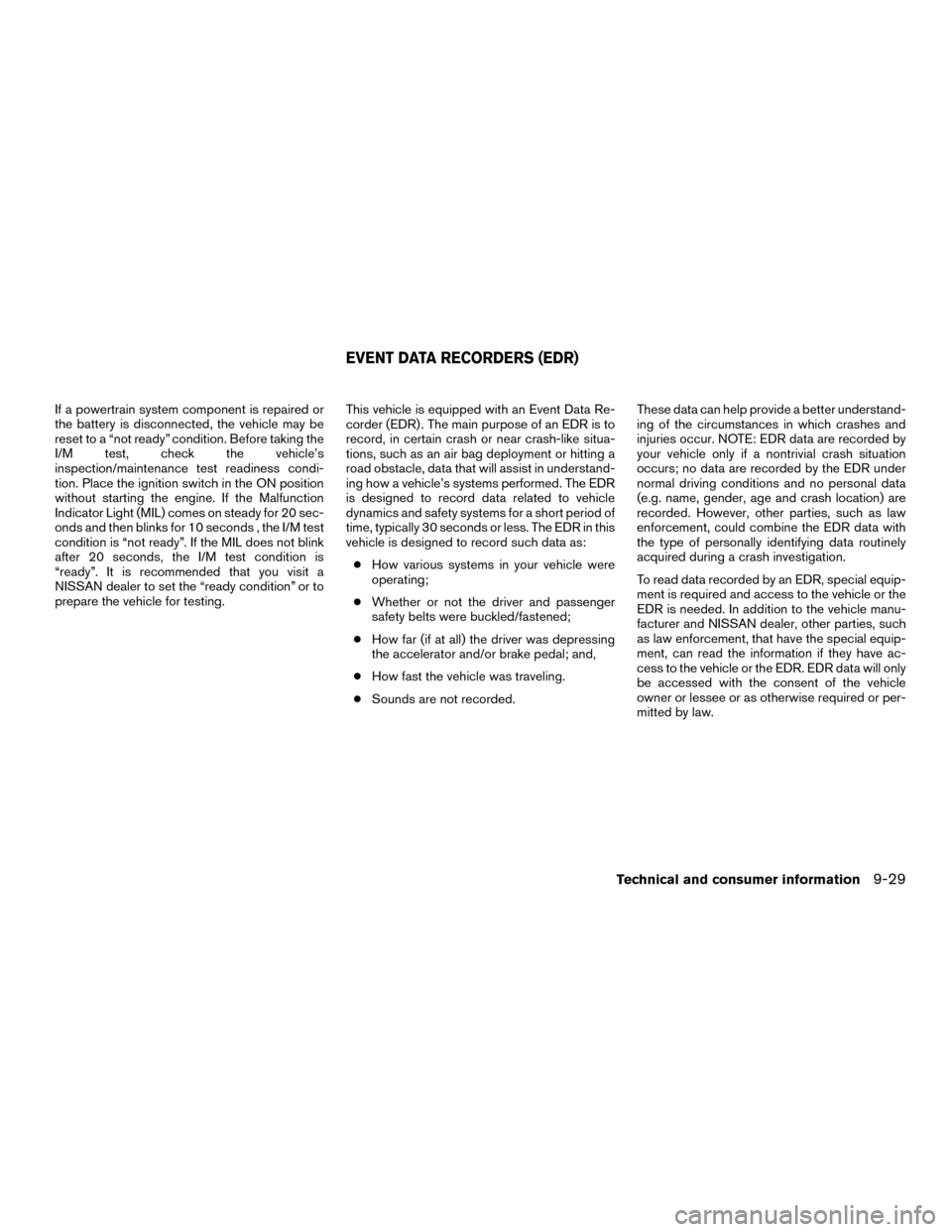
If a powertrain system component is repaired or
the battery is disconnected, the vehicle may be
reset to a “not ready” condition. Before taking the
I/M test, check the vehicle’s
inspection/maintenance test readiness condi-
tion. Place the ignition switch in the ON position
without starting the engine. If the Malfunction
Indicator Light (MIL) comes on steady for 20 sec-
onds and then blinks for 10 seconds , the I/M test
condition is “not ready”. If the MIL does not blink
after 20 seconds, the I/M test condition is
“ready”. It is recommended that you visit a
NISSAN dealer to set the “ready condition” or to
prepare the vehicle for testing.This vehicle is equipped with an Event Data Re-
corder (EDR) . The main purpose of an EDR is to
record, in certain crash or near crash-like situa-
tions, such as an air bag deployment or hitting a
road obstacle, data that will assist in understand-
ing how a vehicle’s systems performed. The EDR
is designed to record data related to vehicle
dynamics and safety systems for a short period of
time, typically 30 seconds or less. The EDR in this
vehicle is designed to record such data as:
● How various systems in your vehicle were
operating;
● Whether or not the driver and passenger
safety belts were buckled/fastened;
● How far (if at all) the driver was depressing
the accelerator and/or brake pedal; and,
● How fast the vehicle was traveling.
● Sounds are not recorded. These data can help provide a better understand-
ing of the circumstances in which crashes and
injuries occur. NOTE: EDR data are recorded by
your vehicle only if a nontrivial crash situation
occurs; no data are recorded by the EDR under
normal driving conditions and no personal data
(e.g. name, gender, age and crash location) are
recorded. However, other parties, such as law
enforcement, could combine the EDR data with
the type of personally identifying data routinely
acquired during a crash investigation.
To read data recorded by an EDR, special equip-
ment is required and access to the vehicle or the
EDR is needed. In addition to the vehicle manu-
facturer and NISSAN dealer, other parties, such
as law enforcement, that have the special equip-
ment, can read the information if they have ac-
cess to the vehicle or the EDR. EDR data will only
be accessed with the consent of the vehicle
owner or lessee or as otherwise required or per-
mitted by law.
EVENT DATA RECORDERS (EDR)
Technical and consumer information9-29
Page 421 of 443
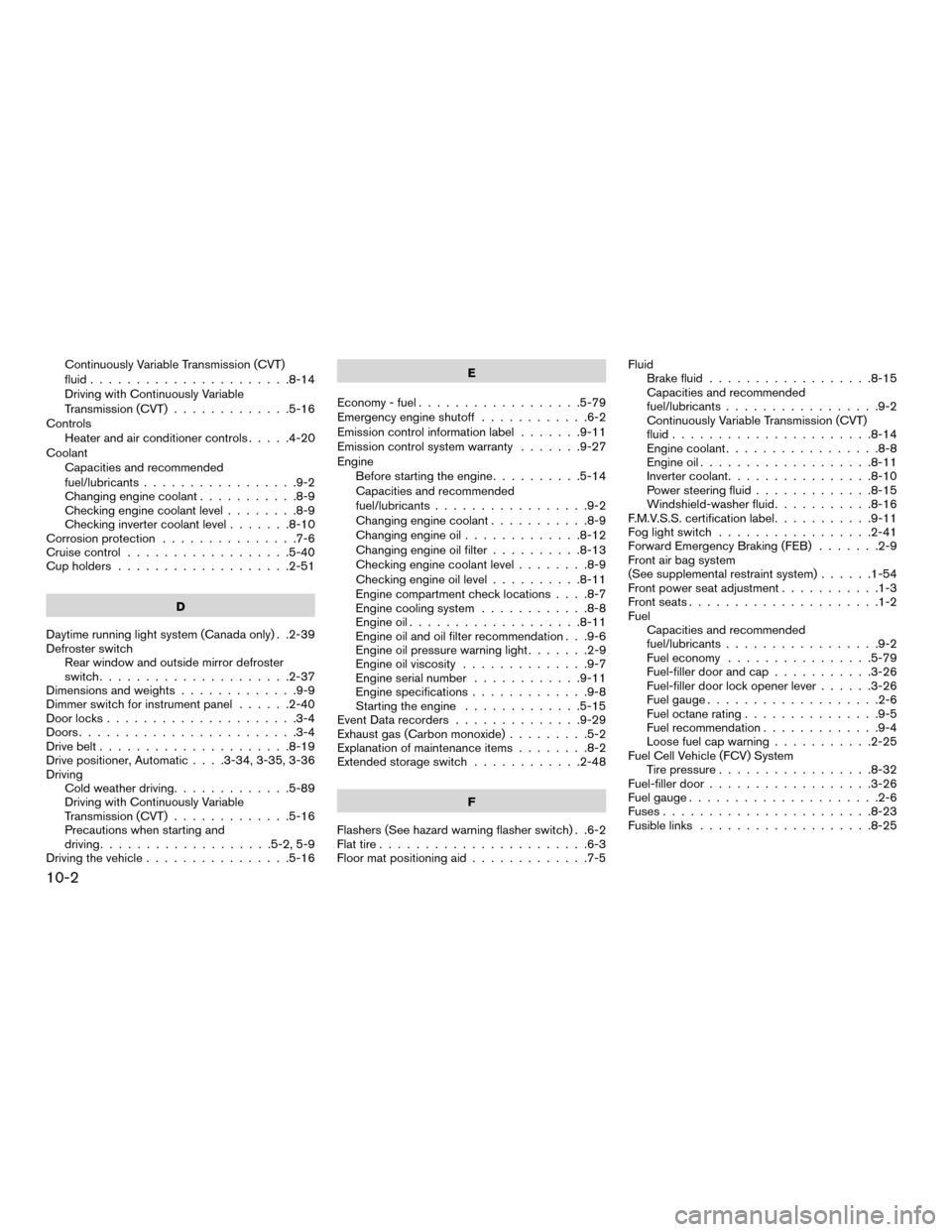
Continuously Variable Transmission (CVT)
fluid......................8-14
Driving with Continuously Variable
Transmission (CVT) .............5-16
Controls Heater and air conditioner controls .....4-20
Coolant Capacities and recommended
fuel/lubricants .................9-2
Changing engine coolant ...........8-9
Checking engine coolant level ........8-9
Checking inverter coolant level .......8-10
Corrosion protection ...............7-6
Cruise control ..................5-40
Cup holders ...................2-51
D
Daytime running light system (Canada only) . .2-39
Defroster switch Rear window and outside mirror defroster
switch .....................2-37
Dimensions and weights .............9-9
Dimmer switch for instrument panel ......2-40
Door locks .....................3-4
Doors ........................3-4
Drive belt .....................8-19
Drive positioner, Automatic . . . .3-34, 3-35, 3-36
Driving Cold weather driving .............5-89
Driving with Continuously Variable
Transmission (CVT) .............5-16
Precautions when starting and
driving ...................5-2, 5-9
Driving the vehicle ................5-16 E
Economy - fuel ..................5-79
Emergency engine shutoff ............6-2
Emission control information label .......9-11
Emission control system warranty .......9-27
Engine Before starting the engine ..........5-14
Capacities and recommended
fuel/lubricants .................9-2
Changing engine coolant ...........8-9
Changing engine oil .............8-12
Changing engine oil filter ..........8-13
Checking engine coolant level ........8-9
Checking engine oil level ..........8-11
Engine compartment check
locations . . . .8-7
Engine cooling system ............8-8
Engine oil ...................8-11
Engine oil and oil filter recommendation . . .9-6
Engine oil pressure warning light .......2-9
Engine oil viscosity ..............9-7
Engine serial number ............9-11
Engine specifications .............9-8
Starting the engine .............5-15
Event Data recorders ..............9-29
Exhaust gas (Carbon monoxide) .........5-2
Explanation of maintenance items ........8-2
Extended storage switch ............2-48
F
Flashers (See hazard warning flasher switch) . .6-2
Flat tire .......................6-3
Floor mat positioning aid .............7-5 Fluid
Brake fluid ..................8-15
Capacities and recommended
fuel/lubricants .................9-2
Continuously Variable Transmission (CVT)
fluid ......................8-14
Engine coolant .................8-8
Engine oil ...................8-11
Inverter coolant ................8-10
Power steering fluid .............8-15
Windshield-washer fluid ...........8-16
F.M.V.S.S. certification label ...........9-11
Fog light switch .................2-41
Forward Emergency Braking (FEB) .......2-9
Front air bag system
(See supplemental restraint system) ......1-54
Front power seat adjustment ...........1-3
Front seats .....................1-2
Fuel Capacities and recommended
fuel/lubricants .................9-2
Fuel economy ................5-79
Fuel-filler door and cap ...........3-26
Fuel-filler door lock opener lever ......3-26
Fuel gauge .................. .2-6
Fuel
octane rating ...............9-5
Fuel recommendation .............9-4
Loose fuel cap warning ...........2-25
Fuel Cell Vehicle (FCV) System Tire pressure .................8-32
Fuel-filler door ..................3-26
Fuel gauge .....................2-6
Fuses .......................8-23
Fusible links ...................8-25
10-2
Page 422 of 443
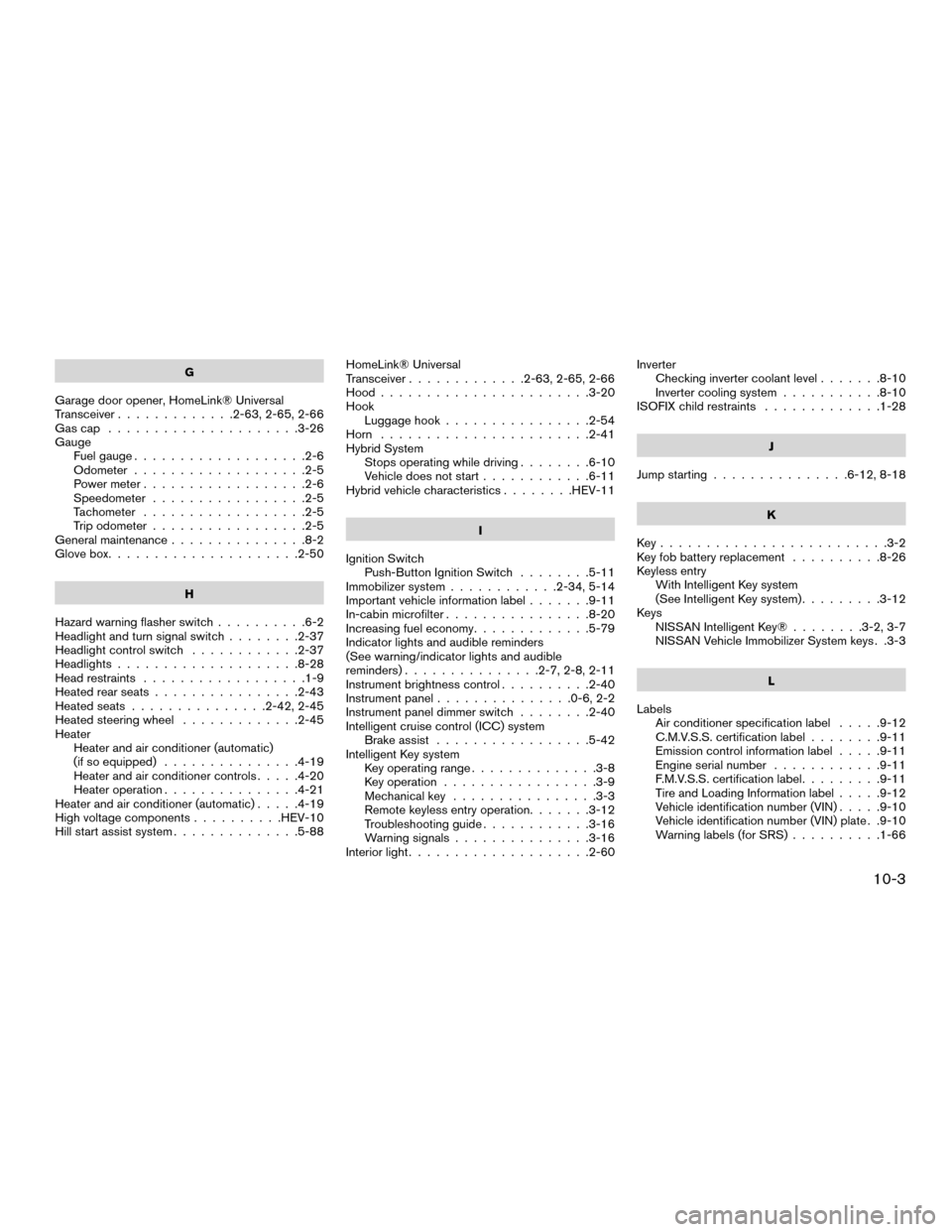
G
Garage door opener, HomeLink® Universal
Transceiver .............2-63, 2-65, 2-66
Gascap .....................3-26
Gauge Fuel gauge ...................2-6
Odometer ...................2-5
Power meter ..................2-6
Speedometer .................2-5
Tachometer ..................2-5
Trip odometer .................2-5
General maintenance ...............8-2
Glove box .....................2-50
H
Hazard warning flasher switch ..........6-2
Headlight and turn signal switch ........2-37
Headlight control switch ............2-37
Headlights ....................8-28
Head restraints ..................1-9
Heated rear seats ................2-43
Heated seats ...............2-42, 2-45
Heated steering wheel .............2-45
Heater Heater and air conditioner (automatic)
(if so equipped) ...............4-19
Heater and air conditioner controls .....4-20
Heater operation ...............4-21
Heater and air conditioner (automatic) .....4-19
High voltage components ..........HEV-10
Hill start assist system ..............5-88 HomeLink® Universal
Transceiver
.............2-63, 2-65, 2-66
Hood .......................3-20
Hook Luggage hook ................2-54
Horn .......................2-41
Hybrid System Stops operating while driving ........6-10
Vehicle does not start ............6-11
Hybrid vehicle characteristics ........HEV-11
I
Ignition Switch Push-Button Ignition Switch.......
.5-11
Immobilizer system ............2-34, 5-14
Important vehicle information label .......9-11
In-cabin microfilter ................8-20
Increasing fuel economy .............5-79
Indicator lights and audible reminders
(See warning/indicator lights and audible
reminders) ...............2-7, 2-8, 2-11
Instrument brightness control ..........2-40
Instrument panel ...............0-6, 2-2
Instrument panel dimmer switch ........2-40
Intelligent cruise control (ICC) system Brake assist .................5-42
Intelligent Key system Key operating range ..............3-8
Key operation .................3-9
Mechanical key ................3-3
Remote keyless entry operation .......3-12
Troubleshooting guide ............3-16
Warning signals ...............3-16
Interior light ....................2-60 Inverter
Checking inverter coolant level .......8-10
Inverter cooling system ...........8-10
ISOFIX child restraints .............1-28
J
Jump starting ...............6-12, 8-18
K
Key.........................3-2
Key fob battery replacement ..........8-26
Keyless entry With Intelligent Key system
(See Intelligent Key system) .........3-12
Keys NISSAN Intelligent Key® ........3-2, 3-7
NISSAN Vehicle Immobilizer System keys . .3-3
L
Labels Air conditioner specification label .....9-12
C.M.V.S.S. certification label ........9-11
Emission control information label .....9-11
Engine serial number ............9-11
F.M.V.S.S. certification label .........9-11
Tire and Loading Information label .....9-12
Vehicle identification
number (VIN) .....9-10
Vehicle identification number (VIN) plate . .9-10
Warning labels (for SRS) ..........1-66
10-3
Page 423 of 443
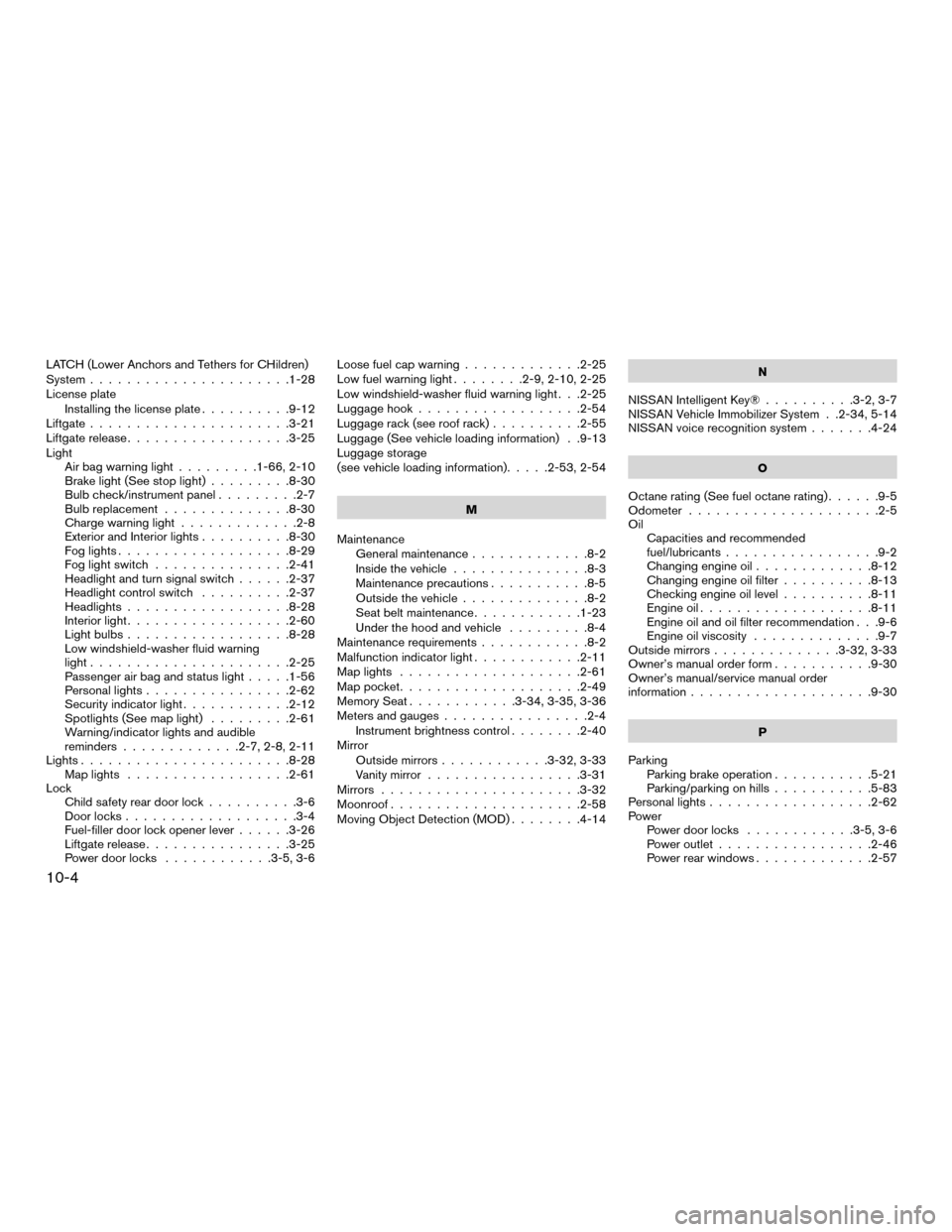
LATCH (Lower Anchors and Tethers for CHildren)
System......................1-28
License plate Installing the license plate ..........9-12
Liftgate ......................3-21
Liftgate release ..................3-25
Light Air bag warning light .........1-66, 2-10
Brake light (See stop light) .........8-30
Bulb check/instrument panel .........2-7
Bulb replacement ..............8-30
Charge warning light .............2-8
Exterior and Interior lights ..........8-30
Fog lights ...................8-29
Fog light switch ...............2-41
Headlight and turn signal switch ......2-37
Headlight control switch ..........2-37
Headlights ..................8-28
Interior light ..................2-60
Light bulbs ..................8-28
Low windshield-washer fluid warning
light ......................2-25
Passenger air bag and status light .....1-56
Personal lights ................2-62
Security indicator light ............2-12
Spotlights (See map light) .........2-61
Warning/indicator lights and audible
reminders .............2-7, 2-8, 2-11
Lights .......................8-28
Map lights ..................2-61
Lock Child safety rear door lock ..........3-6
Door locks ...................3-4
Fuel-filler door lock opener lever ......3-26
Liftgate release ................3-25
Power door locks ............3-5, 3-6 Loose fuel cap warning
.............2-25
Low fuel warning light ........2-9, 2-10, 2-25
Low windshield-washer fluid warning light . . .2-25
Luggage hook ..................2-54
Luggage rack(see
roof rack)..........2-55
Luggage (See vehicle loading information) . .9-13
Luggage storage
(see vehicle loading information) .....2-53, 2-54
M
Maintenance General maintenance .............8-2
Inside the vehicle ...............8-3
Maintenance precautions ...........8-5
Outside the vehicle ..............8-2
Seat belt maintenance ............1-23
Under the hood and vehicle .........8-4
Maintenance requirements ............8-2
Malfunction indicator light ............2-11
Map lights ....................2-61
Map pocket ....................2-49
Memory Seat ............3-34, 3-35, 3-36
Meters and gauges ................2-4
Instrument brightness control ........2-40
Mirror Outside mirrors ............3-32, 3-33
Vanity mirror .................3-31
Mirrors ......................3-32
Moonroof .....................2-58
Moving Object Detection (MOD) ........4-14 N
NISSAN Intelligent Key® ..........3-2, 3-7
NISSAN Vehicle Immobilizer System . .2-34, 5-14
NISSAN voice recognition system .......4-24
O
Octane rating (See fuel octane rating) ......9-5
Odometer .....................2-5
Oil Capacities and recommended
fuel/lubricants .................9-2
Changing engine oil .............8-12
Changing engine oil filter ..........8-13
Checking engine oil level ..........8-11
Engine oil ...................8-11
Engine oil and oil filter recommendation . . .9-6
Engine oil viscosity ..............9-7
Outside mirrors ..............3-32, 3-33
Owner’s manualorder
form ...........9-30
Owner’s manual/service manual order
information ....................9-30
P
Parking Parking brake operation ...........5-21
Parking/parking on hills ...........5-83
Personal lights ..................2-62
Power Power door locks ............3-5, 3-6
Power outlet .................2-46
Power rear windows .............2-57
10-4
Page 424 of 443
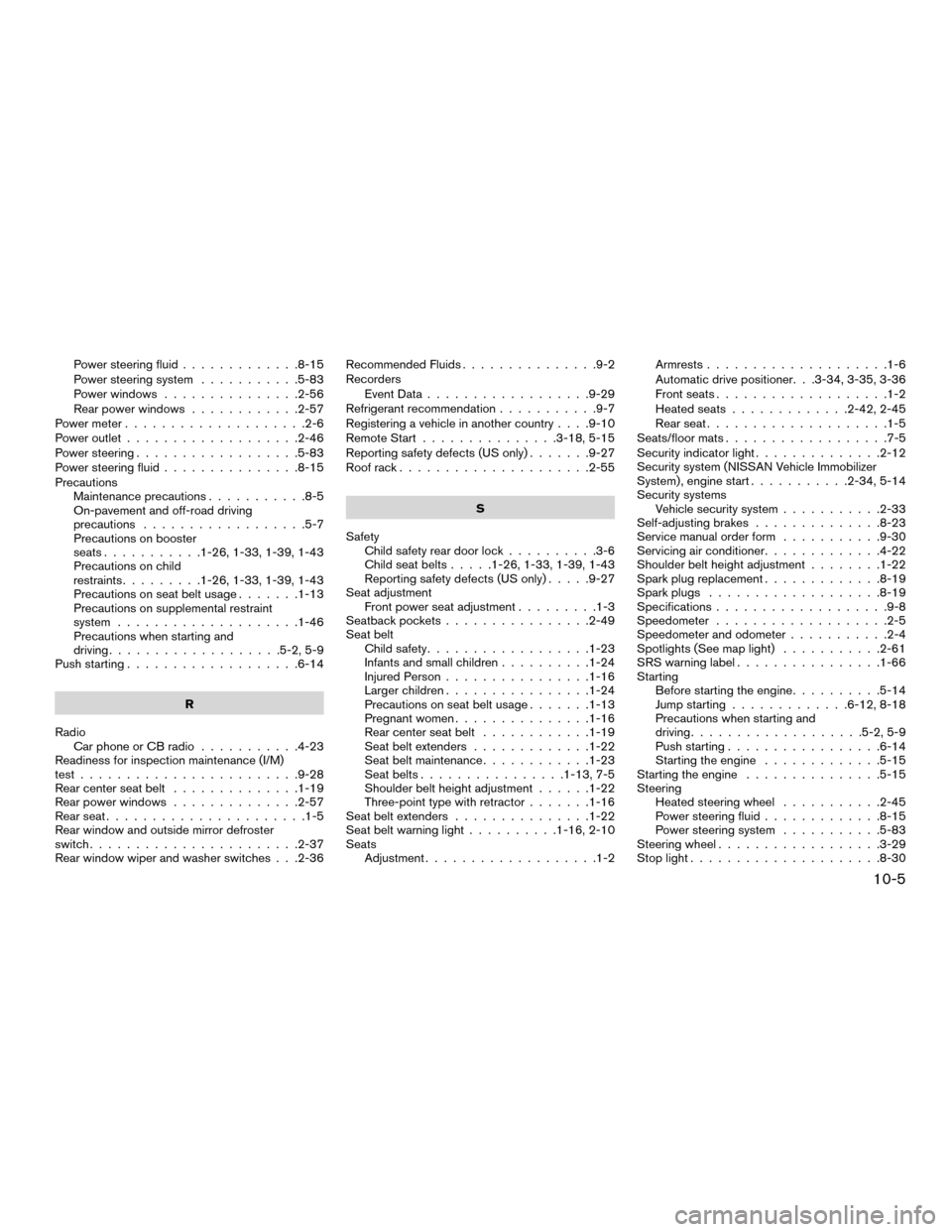
Power steering fluid.............8-15
Power steering system ...........5-83
Power windows ...............2-56
Rear power windows ............2-57
Power meter ....................2-6
Power outlet ...................2-46
Power steering ..................5-83
Power steering fluid ...............8-15
Precautions Maintenance precautions ...........8-5
On-pavement and off-road driving
precautions ..................5-7
Precautions on booster
seats ...........1-26, 1-33, 1-39, 1-43
Precautions on child
restraints .........1-26, 1-33, 1-39, 1-43
Precautions on seat belt usage .......1-13
Precautions on supplemental restraint
system ....................1-46
Precautions when starting and
driving ...................5-2, 5-9
Push starting ...................6-14
R
Radio Car phone or CB radio ...........4-23
Readiness for inspection maintenance (I/M)
test ........................9-28
Rear center seat belt ..............1-19
Rear power windows ..............2-57
Rear seat ......................1-5
Rear window and outside mirror defroster
switch .......................2-37
Rear window wiper and washer switches . . .2-36 Recommended Fluids
...............9-2
Recorders Event Data ..................9-29
Refrigerant recommendation ...........9-7
Registering a vehicle in another country . . . .9-10
Remote Start ...............3-18, 5-15
Reporting safety defects (US only) .......9-27
Roof rack .....................2-55
S
Safety Child safety rear door lock ..........3-6
Child seat belts .....1-26, 1-33, 1-39, 1-43
Reporting safety defects (US only) .....9-27
Seat adjustment
Front power
seat adjustment .........1-3
Seatback pockets ................2-49
Seat belt Child safety ..................1-23
Infants and small children ..........1-24
Injured Person ................1-16
Larger children ................1-24
Precautions on seat belt usage .......1-13
Pregnant women ...............1-16
Rear center seat belt ............1-19
Seat belt extenders .............1-22
Seat belt maintenance ............1-23
Seat belts ................1-13, 7-5
Shoulder belt height adjustment ......1-22
Three-point type with retractor .......1-16
Seat belt extenders ...............1-22
Seat belt warning light ..........1-16, 2-10
Seats Adjustment ...................1-2 Armrests
....................1-6
Automatic drive positioner. . .3-34, 3-35, 3-36
Front seats ...................1-2
Heated seats .............2-42, 2-45
Rear seat ....................1-5
Seats/floor mats ..................7-5
Security indicator light ..............2-12
Security system (NISSAN Vehicle Immobilizer
System) , engine start ...........2-34, 5-14
Security systems Vehicle security system ...........2-33
Self-adjusting brakes ..............8-23
Service manual order form ...........9-30
Servicing air conditioner .............4-22
Shoulder belt height adjustment ........1-22
Spark plug replacement .............8-19
Spark plugs ...................8-19
Specifications ...................9-8
Speedometer ...................2-5
Speedometer and odometer ..........
.2-4
Spotlights (See map light) ...........2-61
SRS warning label ................1-66
Starting Before starting the engine ..........5-14
Jump starting .............6-12, 8-18
Precautions when starting and
driving ...................5-2, 5-9
Push starting .................6-14
Starting the engine .............5-15
Starting the engine ...............5-15
Steering Heated steering wheel ...........2-45
Power steering fluid .............8-15
Power steering system ...........5-83
Steering wheel ..................3-29
Stop light .....................8-30
10-5
Page 427 of 443
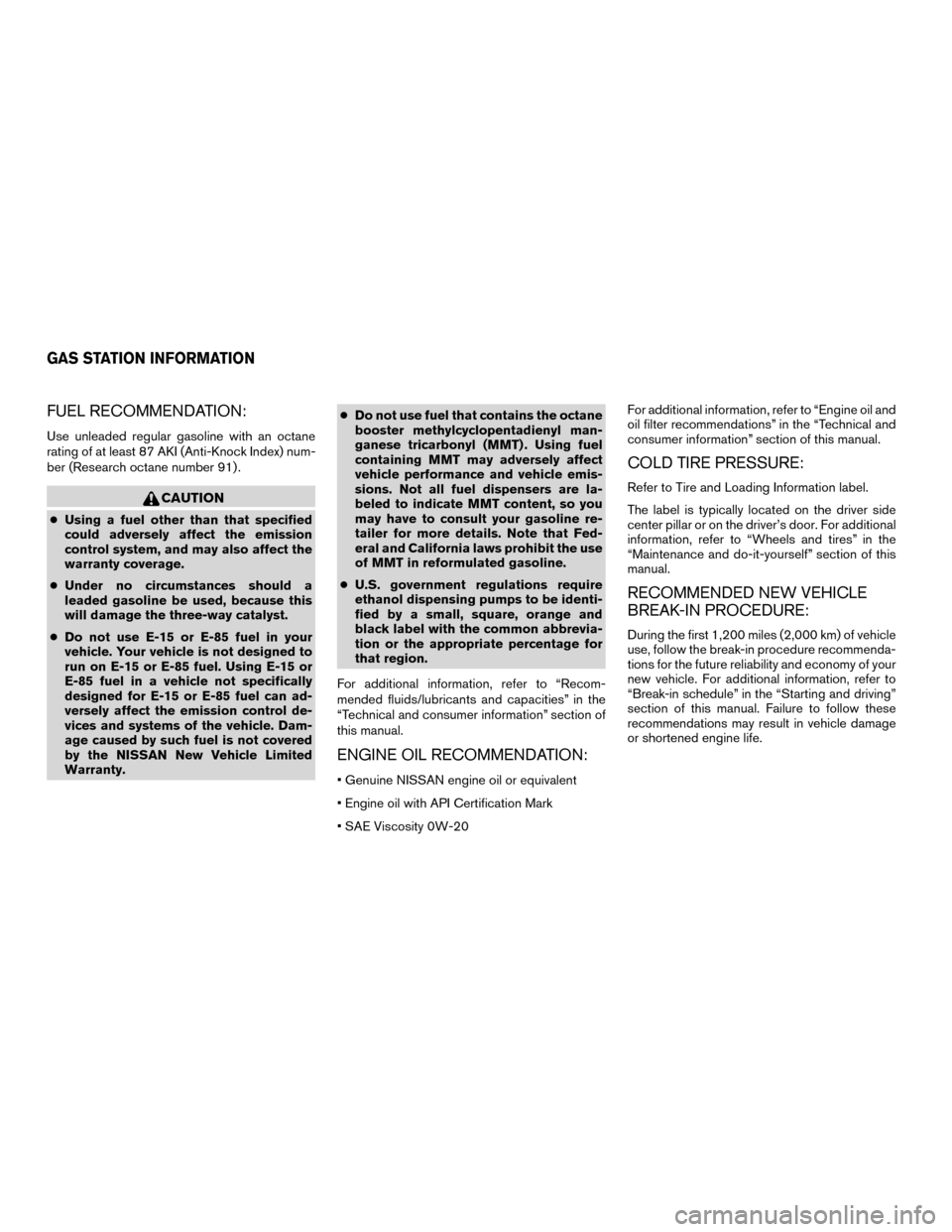
FUEL RECOMMENDATION:
Use unleaded regular gasoline with an octane
rating of at least 87 AKI (Anti-Knock Index) num-
ber (Research octane number 91) .
CAUTION
●Using a fuel other than that specified
could adversely affect the emission
control system, and may also affect the
warranty coverage.
● Under no circumstances should a
leaded gasoline be used, because this
will damage the three-way catalyst.
● Do not use E-15 or E-85 fuel in your
vehicle. Your vehicle is not designed to
run on E-15 or E-85 fuel. Using E-15 or
E-85 fuel in a vehicle not specifically
designed for E-15 or E-85 fuel can ad-
versely affect the emission control de-
vices and systems of the vehicle. Dam-
age caused by such fuel is not covered
by the NISSAN New Vehicle Limited
Warranty. ●
Do not use fuel that contains the octane
booster methylcyclopentadienyl man-
ganese tricarbonyl (MMT) . Using fuel
containing MMT may adversely affect
vehicle performance and vehicle emis-
sions. Not all fuel dispensers are la-
beled to indicate MMT content, so you
may have to consult your gasoline re-
tailer for more details. Note that Fed-
eral and California laws prohibit the use
of MMT in reformulated gasoline.
● U.S. government regulations require
ethanol dispensing pumps to be identi-
fied by a small, square, orange and
black label with the common abbrevia-
tion or the appropriate percentage for
that region.
For additional information, refer to “Recom-
mended fluids/lubricants and capacities” in the
“Technical and consumer information” section of
this manual.
ENGINE OIL RECOMMENDATION:
• Genuine NISSAN engine oil or equivalent
• Engine oil with API Certification Mark
• SAE Viscosity 0W-20 For additional information, refer to “Engine oil and
oil filter recommendations” in the “Technical and
consumer information” section of this manual.
COLD TIRE PRESSURE:
Refer to Tire and Loading Information label.
The label is typically located on the driver side
center pillar or on the driver’s door. For additional
information, refer to “Wheels and tires” in the
“Maintenance and do-it-yourself” section of this
manual.
RECOMMENDED NEW VEHICLE
BREAK-IN PROCEDURE:
During the first 1,200 miles (2,000 km) of vehicle
use, follow the break-in procedure recommenda-
tions for the future reliability and economy of your
new vehicle. For additional information, refer to
“Break-in schedule” in the “Starting and driving”
section of this manual. Failure to follow these
recommendations may result in vehicle damage
or shortened engine life.
GAS STATION INFORMATION